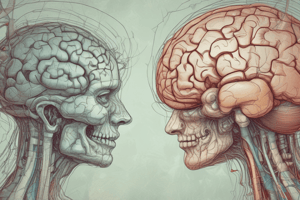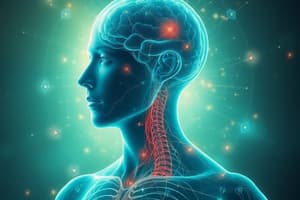Podcast
Questions and Answers
What is the primary function of muscle spindles?
What is the primary function of muscle spindles?
- To protect muscles from over-contraction.
- To generate rapid muscle contractions.
- To insulate larger muscle fibers.
- To detect changes in muscle length. (correct)
How does the Golgi tendon reflex primarily protect muscles?
How does the Golgi tendon reflex primarily protect muscles?
- By sensing muscle tension and causing muscle relaxation. (correct)
- By directly stimulating muscle contraction.
- By increasing muscle sensitivity to pain.
- By monitoring muscle spindle activity.
Which statement accurately compares muscle spindles and Golgi tendon organs (GTOs)?
Which statement accurately compares muscle spindles and Golgi tendon organs (GTOs)?
- Muscle spindles primarily protect against over-stretching, while GTOs primarily protect against over-contraction.
- Muscle spindles initiate muscle relaxation, while GTOs initiate muscle contraction.
- Muscle spindles are located within muscle fibers, while GTOs are located within tendons. (correct)
- Muscle spindles detect muscle tension, while GTOs detect muscle length.
In the flexor (withdrawal) reflex, what is the role of interneurons?
In the flexor (withdrawal) reflex, what is the role of interneurons?
What is the effect of the crossed extensor reflex?
What is the effect of the crossed extensor reflex?
Which statement accurately describes the function of the lateral corticospinal tract?
Which statement accurately describes the function of the lateral corticospinal tract?
Why is the rubrospinal tract considered less prominent in humans compared to other mammals?
Why is the rubrospinal tract considered less prominent in humans compared to other mammals?
Which of the following accurately describes the function of the pontine reticulospinal tract?
Which of the following accurately describes the function of the pontine reticulospinal tract?
How does the medullary reticulospinal tract contrast with the pontine reticulospinal tract?
How does the medullary reticulospinal tract contrast with the pontine reticulospinal tract?
What is the primary function of the vestibulospinal tract?
What is the primary function of the vestibulospinal tract?
Which best describes the function of the lateral vestibulospinal tract?
Which best describes the function of the lateral vestibulospinal tract?
What distinguishes the vestibular nuclei from other motor control centers?
What distinguishes the vestibular nuclei from other motor control centers?
How do the otolith organs contribute to the sense of balance?
How do the otolith organs contribute to the sense of balance?
Which of the following best describes the sensory mechanism of the vestibular apparatus?
Which of the following best describes the sensory mechanism of the vestibular apparatus?
What role does the vestibular system play in motor coordination beyond maintaining balance?
What role does the vestibular system play in motor coordination beyond maintaining balance?
Which function does the brainstem NOT directly control?
Which function does the brainstem NOT directly control?
What is the significance of the red nucleus in the context of motor control?
What is the significance of the red nucleus in the context of motor control?
What happens when the muscle is suddenly stretched?
What happens when the muscle is suddenly stretched?
What enables faster reflexive control of motor function in the spinal cord?
What enables faster reflexive control of motor function in the spinal cord?
Which fibers decussate anterior to the corticospinal tract?
Which fibers decussate anterior to the corticospinal tract?
Which of the following regions is NOT part of the brainstem?
Which of the following regions is NOT part of the brainstem?
Which of the following can the grey matter of the spinal cord control?
Which of the following can the grey matter of the spinal cord control?
The spinal cord...?
The spinal cord...?
What is the role of the cerebellum regarding spinal cord coordination?
What is the role of the cerebellum regarding spinal cord coordination?
Where might a sudden muscle stretch receptor be located?
Where might a sudden muscle stretch receptor be located?
What does the vestibular apparatus primarily detect?
What does the vestibular apparatus primarily detect?
Signals leaving the brainstem are relayed to which areas?
Signals leaving the brainstem are relayed to which areas?
The cerebellum recieves afferent fibers from the spinal cord, similar to those of..?
The cerebellum recieves afferent fibers from the spinal cord, similar to those of..?
The pontine reticulospinal tract descends down which area?
The pontine reticulospinal tract descends down which area?
The vestibular nuclear complex is made up of...?
The vestibular nuclear complex is made up of...?
The vestibular system integrates information from where?
The vestibular system integrates information from where?
What information from the vestibular apparatus does the vestibular system integrate?
What information from the vestibular apparatus does the vestibular system integrate?
What is one of the main functions of the medulla oblongata?
What is one of the main functions of the medulla oblongata?
What effect do signals traveling from the vestibular system have on the eyes?
What effect do signals traveling from the vestibular system have on the eyes?
What part of the brainstem is responsible for equilibrium (balance)?
What part of the brainstem is responsible for equilibrium (balance)?
The membrane labyrinth is filled with what kind of liquid?
The membrane labyrinth is filled with what kind of liquid?
The sensory system is responsible for detecting equilibrium. Where does this happen?
The sensory system is responsible for detecting equilibrium. Where does this happen?
How do signals from the vestibular system contribute to gaze stabilization during head movements?
How do signals from the vestibular system contribute to gaze stabilization during head movements?
In what way does the medullary reticulospinal tract's function differ significantly from the pontine reticulospinal tract?
In what way does the medullary reticulospinal tract's function differ significantly from the pontine reticulospinal tract?
What is the functional significance of the rubrospinal tract's decussation in the context of motor control?
What is the functional significance of the rubrospinal tract's decussation in the context of motor control?
How does the vestibular system utilize the kinocilia and stereocilia within the vestibular apparatus to detect head movements?
How does the vestibular system utilize the kinocilia and stereocilia within the vestibular apparatus to detect head movements?
How does the interplay between the muscle spindle and Golgi tendon organ (GTO) contribute to precise motor control during a novel motor task?
How does the interplay between the muscle spindle and Golgi tendon organ (GTO) contribute to precise motor control during a novel motor task?
Flashcards
Grey Matter Sensory Role
Grey Matter Sensory Role
Sensory fibers enter and are processed by the grey matter. Cerebral cortex receives signals.
Muscle Spindle Structure
Muscle Spindle Structure
Located inside skeletal muscles, consisting of 3 to 12 intrafusal muscle fibers insulated by a capsule.
Muscle Spindle Function
Muscle Spindle Function
Detect changes in muscle length and transmit signals to the spinal cord via afferent fibers.
Stretch Reflex Mechanism
Stretch Reflex Mechanism
Signup and view all the flashcards
Spinal Cord Synapse
Spinal Cord Synapse
Signup and view all the flashcards
Patellar Tendon Reflex
Patellar Tendon Reflex
Signup and view all the flashcards
Golgi Tendon Organ (GTO)
Golgi Tendon Organ (GTO)
Signup and view all the flashcards
GTO Stimulation
GTO Stimulation
Signup and view all the flashcards
GTO Functional Role
GTO Functional Role
Signup and view all the flashcards
GTO-Spinal Cord Interaction
GTO-Spinal Cord Interaction
Signup and view all the flashcards
Spinal Cord Coordination
Spinal Cord Coordination
Signup and view all the flashcards
Cerebellum Influence
Cerebellum Influence
Signup and view all the flashcards
Flexor (Withdrawal) Reflex
Flexor (Withdrawal) Reflex
Signup and view all the flashcards
Flexor Reflex Action
Flexor Reflex Action
Signup and view all the flashcards
Crossed Extensor Reflex
Crossed Extensor Reflex
Signup and view all the flashcards
Functional Importance
Functional Importance
Signup and view all the flashcards
Ventral Motor Tracts
Ventral Motor Tracts
Signup and view all the flashcards
Lateral Motor Tracts
Lateral Motor Tracts
Signup and view all the flashcards
Ventral Tract Function
Ventral Tract Function
Signup and view all the flashcards
Medullary Reticulospinal Tract
Medullary Reticulospinal Tract
Signup and view all the flashcards
Vestibular Apparatus
Vestibular Apparatus
Signup and view all the flashcards
Vestibular Apparatus Signals
Vestibular Apparatus Signals
Signup and view all the flashcards
Sensory Mechanism
Sensory Mechanism
Signup and view all the flashcards
Brainstem Structure
Brainstem Structure
Signup and view all the flashcards
Brainstem Controls
Brainstem Controls
Signup and view all the flashcards
Equilibrium Control
Equilibrium Control
Signup and view all the flashcards
Red Nucleus
Red Nucleus
Signup and view all the flashcards
Rubrospinal Tract
Rubrospinal Tract
Signup and view all the flashcards
Rubrospinal Fibers
Rubrospinal Fibers
Signup and view all the flashcards
Rubrospinal Relationship
Rubrospinal Relationship
Signup and view all the flashcards
Pontine Reticulospinal
Pontine Reticulospinal
Signup and view all the flashcards
Medullary Reticulospinal
Medullary Reticulospinal
Signup and view all the flashcards
Medullary Reticulospinal Function
Medullary Reticulospinal Function
Signup and view all the flashcards
Vestibulospinal Tracts
Vestibulospinal Tracts
Signup and view all the flashcards
Vestibulospinal Function
Vestibulospinal Function
Signup and view all the flashcards
Vestibulospinal Control
Vestibulospinal Control
Signup and view all the flashcards
Lateral Vestibulospinal
Lateral Vestibulospinal
Signup and view all the flashcards
Vestibular Nuclei Input
Vestibular Nuclei Input
Signup and view all the flashcards
Vestibular Subnuclei
Vestibular Subnuclei
Signup and view all the flashcards
Vestibular System Role
Vestibular System Role
Signup and view all the flashcards
Vestibular System Function
Vestibular System Function
Signup and view all the flashcards
Study Notes
- Presented with xmind
Motor Function - Physiology | Mind Map
- Brainstem coordination and spinal cord coordination are key components.
Brainstem Coordination
- Includes the pons and medulla oblongata.
- Extension of the spinal cord into the cranial cavity.
- Similar to how the spinal cord controls motor and sensory function, the brainstem has these same responsibilities, but in the cranial region.
- Control of respiration by regulating breathing rate and rhythm.
- The brainstem controls cardiovascular circulation via blood pressure.
- Partial control of gastrointestinal functions, influencing digestion and peristalsis.
- It exerts control over many stereotyped motor patterns that are repetitive.
- Integrates sensory input from the vestibular system for equilibrium and balance.
- Eye movement control is managed by the vestibular system, such as gaze control.
Brainstem Motor Tracts
- The primary motor cortex signals are voluntarily sent to the brainstem and relayed to the spinal cord to impact motor function.
- Motor tract origins:
- Red nucleus (midbrain) is the origin of the rubrospinal tract.
- Pontine reticular formation of the pons is the origin of the pontine reticulospinal tract.
- Medullary reticular formation of the medulla oblongata is the origin of the medullary reticulospinal tract.
- Vestibular nuclei in the medulla oblongata are the origin of the vestibulospinal tract.
Major Motor Tracts
- Rubrospinal Tract:
- Originates from the red nucleus in the midbrain.
- Plays a role in coordinating movements.
- These fibers synapse in the spinal cord.
- Direct input from the cerebellum allows for faster reflexive control of movements.
- Fibers decussate (cross over) in midbrain.
- Located lateral and slightly anterior to the corticospinal tract in the spinal cord.
- Specific Functions (Cortiocspinal vs Rubrospinal)
- While the rubrospinal assists the corticospinal, it is especially prominent or more important in development.
- The spinocerebellum receives motor information.
- The cerebellum receives input from the red nucleus, similar to those of the motor cortex, allowing for fine-tuning and coordination of movements.
- The pontine (medial) reticulospinal Tract:
- Origin and Pathway: Originates in the pontine nuclei of the pons; descends through the ventral column (postural muscles of the limbs) of the spinal cord.
- Innervates extensor muscles of the limbs.
- The pontine works with the vestibular and cerebellar systems.
- The medullary (lateral) reticulospinal Tract:
- Origin and Pathway: Originates in the medullary reticular formation of the medulla oblongata and descends in the ventral column of the spinal cord.
- The tract contains both ipsilateral and contralateral fibers
- Opposes the pontine reticulospinal tract by inhibiting extensor muscles and exciting flexor muscles.
- Functional Importance: Balances the effects of the pontine reticulospinal tract for smooth postural control.
- Overview of Vestibulospinal Tract
- Tracts originate from vestibular nuclei in the medulla oblongata that gets visual input and controls equilibrium.
- Excites extensor muscles and inhibits flexor muscles.
- Works in close association with signals to the antigravity muscles (muscles that maintain posture while standing).
- The Lateral Vestibulospinal Tract controls limb extensors.
- Originates from the lateral vestibular nucleus is in the medulla.
- Descends ipsilaterally in "ventral white matter" of spinal cord.
- Selectively controls excitatory signals to different antigravity muscles to maintain balance during standing in response to changes in head position
- Both pontine and medullary reticulospinal tracts primarily control axial muscles of the trunks (postural and "gross" movements).
- Vestibular Nuclei
- The vestibular nuclear complex consists of four subnuclei that integrate sensory signals for balance in the brainstem.
- The medial vestibular nuclei receive input from the semi-circular canals.
- The lateral vestibular nuclei receive input from the otolith organs.
- Role of the Vestibular System in Motor Control
- Head position relative to gravity.
- Head acceleration through space.
- The vestibular system integrates information from the cerebellum, making it essential for motor coordination.
- Unlike other motor control centers, the vestibular nuclei do not receive direct corticospinal projections (i.e., no descending voluntary signals are sent)
Vestibular Apparatus
- Located within a bony labyrinth within the temporal bone.
- Cochlea for hearing
- Otolith Organs - two chambers.
- Detect linear acceleration and head tilt
- Semicircular Canals -Detect angular acceleration (rotation).
- Components:
- Static tilt (e.g., holding the head at an angle)
- Rotational acceleration (e.g., turning the head)
- Function:
- Constantly sends signals to the oculomotor brainstem and cerebellum.
- Stabilizes vision, ensuring that the eyes move in coordination with the head.
- Pathways for vision: Oculomotor
- Pathways for balance control: Cerebellum/Vestibulospinal tract.
- Membranous Labyrinth
- Filled with endolymph, containing hair cells embedded in a gelatinous matrix.
- Movement of endolymph causes fluid displacement, which bends the stereocilia (hair), either causing
- Depolarization
- Hyperpolarization
- Sends signals to the CNS. The neural pathway begins at the vestibular ganglion.
Spinal Cord Coordination
- Spinal cord reflexes are not just for reflexes. They can also be affected by the central nervous system.
The Grey Matter as an Integrator
- Sensory Signal Entry and Processing
- Sensory fibers enter the dorsal horn, forming ascending pathways to higher centers (e.g., thalamus, cerebral cortex), and affect primary motor neurons
- When a muscle is stretched, the muscle spindle activates; also generating inhibitory signals toward antagonist muscles.
Muscle Spindle
- Now the spinal cord - Muscle Spindle
- Also referred to as "intrafusial fibers".
- Directly innervate to receptor located inside skeletal muscle.
- It consists of 3 to 12 specialized muscle fibers.
- The larger muscle fibers outside the spindle are insulfusial fibers.
- Structure: -A proprioceptive sensory receptor that detects changes in muscle length.
- Function:
- Transmits signals to the spinal cord via 2 types of afferent sensory fibers.
- When the muscle is not stretched then there is baseline firing rate.
- Muscle Stretch → Generating afferent impulses that travel to spinal cord.
- Sensory fibers synapse directly with alpha motor neurons of the same muscle → Quadriceps Contract
- The stretch reflex mechanism includes muscle stretch and contraction.
- The importance of the stretch reflex is to increase muscle tone, counteract gravity, and maintain posture
- Role of Grey Matter
- Example of the patellar tendon reflex (knee-jerk reaction): Tapping the patellar tendon stretches the quadriceps muscle, activating its muscle spindle. This activation causes the quadriceps, therefore raising the leg
Spinal Cord Coordination
- Key characteristics of the Golgi Tendon Organ (GTO)
- Does not result in rapid reflexes like those in the brain.
- Structure:
- Encapsulated sensory receptor located within tendons near the muscle-tendon junction.
- Active contractions stimulate the Golgi Tendon Organ (GTO)
- Passive stretching of the muscle whether due to internal or external forces will also stimulate contraction.
- Protect Muscle and Bone:
- When muscle tension is too high, afferent signals from the GTO excite inhibitory interneurons in the spinal cord to promote muscle relaxation.
- Functional Role of the Golgi Tendon Reflex
- Detects Muscle contraction force when information from GTO enters dorsal horn and is integrated in spinal cord.
- Integrated with info from muscle spindle.
- Spinal cord also acts as a pattern generator and motor control center.
- Difference
- Muscle spindle signals when stretched, whereas GTO signals strength of contraction
- The spinocerebellar projects copy the information from the spinal cord.
- Anterior carries internally (muscle spindle)
- Posterior carries from external (GTO)
- The dorsal column-medial lemniscus pathway signals touch (Messner's/pacinian corpuscles) and pain (free nerve endings)
Flexor & Crossed Extension Reflex
- A painful stimulus activates nociceptors, sending afferent signals to the spinal cord resulting in the Flexor (Withdrawal Reflex).
- Excitation of ipsalateral flexor muscles leads to the withdrawal of the pained limb.
- Inhibition of ipsilateral extensor muscles ensures the limb can flex and retract.
- Stimulation of contralateral extensor muscles.
- Inhibition of contralateral flexor muscles.
- Crossed Extensor Reflex:
- Supports the body when the opposite limb is withdrawn because the limb feels a sudden increase in load
- Functional Importance from Step-on-a-Tack Reflex Example
- Activate flexors to lift foot + other muscles provide balance.
- Major descending tracts
- Lateral Tract:
- Lateral Corticospinal (pyramidal)
- Rubrospinal
- Anterior/Ventral tract:
- Anterior Corticospinal (pyramidal)
- Vestibulospinal
- Reticulospinal
- Tectospinal
- Lateral Tract:
Motor Function Coordination-Descending Tracts
- Functional Differences in Tracts:
- Lateral tracts
- (e.g., corticospinal, rubrospinal) primarily control distal muscles for precise and voluntary movements.
- Ventral tracts
- (e.g., pontine reticulospinal, vestibulospinal) primarily control axial muscles (postural and gross motor control)
- One exception is the medullary reticulospinal tract, which inhibits limb and axial muscles more than distal limb muscles.
- Lateral tracts
Studying That Suits You
Use AI to generate personalized quizzes and flashcards to suit your learning preferences.




